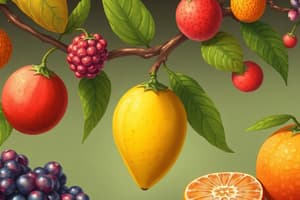Podcast
Questions and Answers
What are the three classifications of fruits?
What are the three classifications of fruits?
- Fleshy, Dry, Aggregate
- Simple, Aggregate, Multiple (correct)
- Simple, Aggregate, Compound
- Simple, Compound, Multiple
Which of the following is NOT a type of simple fruit?
Which of the following is NOT a type of simple fruit?
- Multiple (correct)
- Dry
- Fleshy
- Aggregate
Fruits can be classified as ________, aggregate, or multiple.
Fruits can be classified as ________, aggregate, or multiple.
simple
Fruits can be classified as simple, aggregate, or ______.
Fruits can be classified as simple, aggregate, or ______.
Simple fruits can be ______ or dry.
Simple fruits can be ______ or dry.
What type of fruit tears open along predetermined lines to expose the seeds?
What type of fruit tears open along predetermined lines to expose the seeds?
What are the two types of fleshy fruits?
What are the two types of fleshy fruits?
Simple fruits can be ________ or dry.
Simple fruits can be ________ or dry.
What is the difference between dehiscent and indehiscent fruits?
What is the difference between dehiscent and indehiscent fruits?
Fleshy fruits include berries, drupes, and ______.
Fleshy fruits include berries, drupes, and ______.
Which type of fruit does not dehisce and disperses as one unit?
Which type of fruit does not dehisce and disperses as one unit?
Fleshy fruits include ________, drupes, and pomes.
Fleshy fruits include ________, drupes, and pomes.
What are aggregate fruits formed from?
What are aggregate fruits formed from?
What type of reproduction involves the development of an embryo from a diploid cell in the ovule?
What type of reproduction involves the development of an embryo from a diploid cell in the ovule?
Dry fruits can be ________ or indehiscent.
Dry fruits can be ________ or indehiscent.
Dry fruits can be dehiscent or ______.
Dry fruits can be dehiscent or ______.
Dehiscent fruits tear open along predetermined lines to expose the ______.
Dehiscent fruits tear open along predetermined lines to expose the ______.
Dehiscent fruits tear open along predetermined lines to expose the ________.
Dehiscent fruits tear open along predetermined lines to expose the ________.
Which plant reproduces asexually through apomixis?
Which plant reproduces asexually through apomixis?
How do seeds get dispersed?
How do seeds get dispersed?
Indehiscent fruits do not dehisce and the ovary along with the enclosed seed disperses as ______ unit.
Indehiscent fruits do not dehisce and the ovary along with the enclosed seed disperses as ______ unit.
Indehiscent fruits do not dehisce and the ovary along with the enclosed seed disperses as one ________.
Indehiscent fruits do not dehisce and the ovary along with the enclosed seed disperses as one ________.
What is the benefit of apomixis in crop production?
What is the benefit of apomixis in crop production?
What is apomixis?
What is apomixis?
Aggregate fruits are formed from a single flower with many ______ carpels.
Aggregate fruits are formed from a single flower with many ______ carpels.
What is a benefit of apomixis in crop production?
What is a benefit of apomixis in crop production?
Aggregate fruits are formed from a single flower with many unfused ________.
Aggregate fruits are formed from a single flower with many unfused ________.
Which type of fruit is formed from a single flower with many unfused carpels?
Which type of fruit is formed from a single flower with many unfused carpels?
What is the name for the type of reproduction that is a natural form of cloning?
What is the name for the type of reproduction that is a natural form of cloning?
Apomixis is a type of reproduction that doesn't involve pollen or ________.
Apomixis is a type of reproduction that doesn't involve pollen or ________.
Asexual reproduction is an effective way for plants to sidestep the expenses of ______ reproduction.
Asexual reproduction is an effective way for plants to sidestep the expenses of ______ reproduction.
Which plant reproduces asexually through apomixis?
Which plant reproduces asexually through apomixis?
Study Notes
- Fruits can be classified as simple, aggregate, or multiple.
- Simple fruits can be fleshy or dry.
- Fleshy fruits include berries, drupes, and pomes.
- Dry fruits can be dehiscent or indehiscent.
- Dehiscent fruits tear open along predetermined lines to expose the seeds.
- Indehiscent fruits do not dehisce and the ovary along with the enclosed seed disperses as one unit.
- Aggregate fruits are formed from a single flower with many unfused carpels.
- Multiple fruits develop from an inflorescence.
- Seeds can be dispersed by biotic and abiotic vectors.
- Asexual reproduction is an effective way for plants to sidestep the expenses of sexual reproduction.- Apomixis is a type of reproduction that doesn't involve pollen or fertilization.
- It results in the development of an embryo from a diploid cell in the ovule.
- The dandelion plant reproduces asexually through apomixis.
- The fruits that develop on a dandelion plant are of asexual origin.
- Dandelions don't require pollination to reproduce.
- Apomixis allows for the creation of genetically identical offspring.
- Apomixis is a rare form of reproduction in most plants.
- It's a natural form of cloning.
- Apomixis is being studied for its potential use in agriculture.
- The ability to produce genetically identical offspring can be beneficial in crop production.
Studying That Suits You
Use AI to generate personalized quizzes and flashcards to suit your learning preferences.
Description
Test your knowledge on the various types of fruits and their classification in this informative quiz. Learn about the differences between fleshy and dry fruits, dehiscent and indehiscent fruits, and aggregate and multiple fruits. Explore the fascinating world of plant reproduction and discover the rare form of asexual reproduction known as apomixis. Test your understanding of how apomixis can be beneficial in crop production and why it's being studied for its potential use in agriculture. Put your knowledge to the




